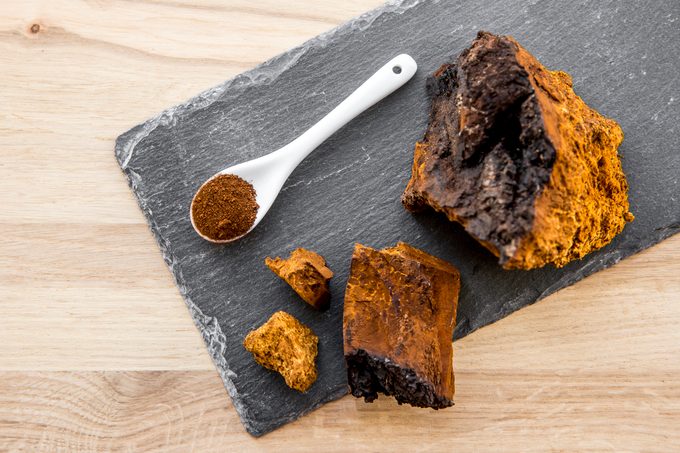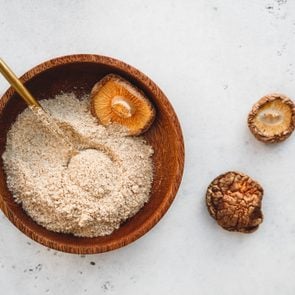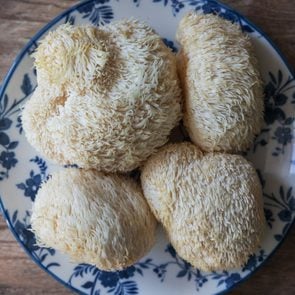5 Reasons to Consider Chaga Mushrooms
Updated: Mar. 16, 2022
Like the fungus they are, chaga mushrooms are spreading rapidly. Here's why you're seeing chaga tea, coffee, and supplements all over social media—and how they might help your health.
What is a chaga mushroom?
This mushroom certainly doesn’t look like anything you would want to touch, let alone eat. But despite its knobby, charcoal, tumor-like appearance, Chaga has a lot going for it.
Chaga is the common name for the fungus Inonotus obliquus. It’s actually a cancerous growth that occurs almost exclusively on birch trees, often killing the tree once it invades the tree’s interior.
Sounds appetizing, right? But while the chaga mushroom signals impending death for a tree, the opposite is true for humans.
The powerful antioxidants in this fungus may potentially prevent or slow tumor growth. Other possible chaga benefits include lowering cholesterol and fighting heart disease.
But what does the research say about these possible benefits? We’re diving deeper into what you should know before breaking into a chunk of chaga or making a cup of chaga mushroom coffee for better health.
Yes, you’re totally seeing chaga everywhere
Raise your hand if your social media feed is loaded with people extolling the benefits of chaga mushrooms. You’re not the only one.
Their newfound popularity ties to the pandemic and social media. People are looking for easy ways to layer on more immune-boosting protection. And, well, they like to post about it.
Mushroom supplements saw double-digit growth of 46 percent in 2020, according to Nutritional Outlook. The chaga market specifically grew by 11.9 percent.
These mushrooms may be the ugly darling of nutritional supplements today, but they are an herbal medicine dating back thousands of years in Russia and Asia.
What do you do with chaga?
One of the most popular ways to get the benefits of chaga mushrooms is to drink them in tea or coffee. Interestingly, during WWII and a related coffee shortage, Finland used chaga to make coffee.
Chaga powder also mixes well into smoothies or pancake batter, and it comes in pill form too.
What’s so great about chaga?
The appeal of chaga stems from its medicinal value rather than nutrition. After all, people aren’t scooping up chaga mushrooms at the grocery store and adding them to salads or tossing them into a stir-fry.
You might see nutrition “facts” on websites that sell chaga, but there’s no evidence to support the nutrition values.
What we do know from research is that chaga is chock-full of antioxidants, its claim to fame in supporting a host of health conditions, according to the Journal of Ethnopharmacology.
Its antioxidant content may be one reason chaga can potentially protect against diseases and cancer. Another reason: beetulinic acid.
Beetulinic acid, known for its cancer-fighting properties, is found in birch trees, per the International Journal of Molecular Sciences. The chaga mushroom absorbs as it grows on the birch tree.
How is chaga harvested?
Tempted to DIY your own chaga tea? You certainly can—if you can find them.
In the United States, they are predominantly found in Alaska and some other cold-weather states. So depending on where you live, you may be able to find them while you walk in the woods.
Before you go foraging through the forest, remember that many mushrooms are poisonous. All wild mushrooms, including chaga, should be 100 percent positively identified before you eat them. Skip this step, and you could up snacking on chaga’s deadly cousin.
Chaga harvesting happens year-round, but the black, charcoal-like mass is much easier to spot on birch trees in the winter when the leaves are scarce.
There are reports of chaga mushrooms growing up to 30 inches long and 20 inches wide, and weighing around seven to 10 pounds.
These are no delicate button mushrooms. Chaga’s exterior is tough, while the orangey-red inside is soft. People harvest chaga with a hatchet, ax, or knife.
Removing the mushroom doesn’t hurt the tree—it’s likely already dead or dying. If the damage hasn’t reached the tree’s interior, removing the cancerous chaga might save the tree.
Once cut from the tree, chaga is stored in a dry environment with good airflow. From there, it can be broken down into small pieces or ground into powder for supplements and extracts.

Potential health benefits of chaga mushrooms
The studies thus far on the health benefits of chaga are encouraging, though scientists say a lot more research is necessary.
“Chaga can be supportive in cancer treatment. It can assist in lowering blood pressure, cholesterol, and blood sugar, and it can also help the immune system by regulating the cytokines that help increase the immune fighter cells like white blood cells,” says Rossia Parrish, a licensed naturopathic doctor with Boulder Natural Health in Boulder, Colorado.
The caveat is that researchers have conducted only laboratory and animal studies. There haven’t been any human-based clinical trials to assess chaga’s safety, efficacy, or dosage for preventing or treating cardiovascular disease, cancer, diabetes, and other diseases.
Still, people are using chaga mushrooms on their own or under the care of a naturopathic doctor to boost immunity, improve overall health, and support the efforts of treating medical conditions.
Inflammation and immunity
Both animal and test-tube studies in the Journal of Traditional and Complementary Medicine found reduced inflammation and increased antibacterial and antiviral properties through chaga’s ability to increase white blood cells. But without studies in humans, it’s too early to say whether it could work for you.
The findings are intriguing: White blood cells are the body’s main defense against viruses and bacteria, according to Dana Hunnes, PhD, senior dietitian at the Ronald Reagan UCLA Medical Center. They help your body fight off bacteria and viruses, keeping you healthy.
The same research found that chaga mushrooms reduced and prevented the production of cytokines, which are markers for inflammation.
Cancer
Chaga’s most acclaimed attribute is its purported antitumor activities. It’s been harvested and used to treat cancer in several countries, according to Pulmonary Adenocarcinoma: Approaches to Treatment. But again, human studies have yet to support this finding.
“Animal and test-tube studies show that Chaga can prevent and perhaps even slow down cancer cell growth,” says Hunnes, who is also a professor at the Fielding School of Public Health in Los Angeles.
One study in mice showed a 60 percent reduction in tumor size, and a test-tube study of human cells from livers, lungs, breasts, prostates, and colons, showed that chaga prevented the growth of cancer cells, according to Hunnes.
Diabetes
Managing blood sugar is essential for people with diabetes. When blood sugar levels are consistently high, it causes damage to vital organs, the eyes, and the nerves, and it increases the risk of heart disease, stroke, and kidney disease.
People are intrigued by the potential of chaga for managing blood sugar, but so far it’s only been tested in mice.
In a study published in Biomedicine and Pharmacotherapy, researchers fed chaga mushroom extract to a group of overweight mice with type 2 diabetes. Compared with mice who didn’t eat chaga, the mushroom-eating mice had reduced blood sugar levels and insulin resistance.
Cholesterol
With chaga’s high concentration of antioxidants, it may help people who have high cholesterol. This, in turn, could help protect against clogged arteries and heart disease.
In the same Biomedicine and Pharmacotherapy study mentioned above, overweight mice with type 2 diabetes that ate chaga mushroom extract had reduced LDL “bad” cholesterol and increased HDL “good” cholesterol.
Who should avoid chaga mushrooms?
Chaga may interact with medications and other supplements, or it may impact an existing health condition. So talk to your doctor before attempting to add it into your diet.
Keep in mind, chaga mushrooms may prevent the absorption of some nutrients and can be toxic in high doses.
“Chaga mushrooms aren’t without risk,” cautions Parrish.
If you fall into one of the categories below, you may have to avoid chaga.
People with kidney issues
“Their high oxalate content should be a concern to anyone taking chaga,” Parrish says.
Oxalates are in a variety of foods. Their tiny molecules bind minerals like calcium and form crystals, impacting neurological function, connective tissue function, and kidney and bladder function.
If you have kidney issues, avoid chaga mushrooms, Parrish says.
People with osteoporosis
The oxalates in chaga mushrooms are calcium chelators, which means they bind to calcium and eliminate it from the body.
That’s bad news for people with the brittle-bone disease osteoporosis. Calcium is a key mineral for building bones.
“If a patient is osteoporotic, this is another reason to avoid chaga mushrooms, since oxalates will decrease the level of overall bioavailable calcium in the body,” explains Parrish.
People on blood thinners
Don’t take chaga if you are on blood-thinning medications.
“Chaga may also prevent blood from clotting, so if you are blood thinners, you should not take this,” says Hunnes. “And if you are having any procedures done, you should not take it.”
People on diabetes medication
Steer clear of chaga mushrooms if you take medicine to control diabetes.
“Chaga may lower blood sugar levels too much and could be dangerous if you become hypoglycemic,” says Hunnes.
Parrish agrees, noting that if someone is taking medications to regulate insulin, chaga may interfere with the effectiveness of the medication.
“They should work with their doctor to modulate or monitor their medications more closely,” she says.
People with autoimmune diseases
Chaga might cause the immune system to become more active, intensifying the symptoms of autoimmune diseases.
“I would not recommend anyone with autoimmune diseases or anyone who has had organ transplantation to take this, as it may interact with certain medications, making them either less effective or more effective, which could be dangerous,” says Hunnes.
People who are pregnant or breastfeeding
“Pregnant and lactating women should not take it either, as it may pass to the baby through the placenta or breastfeeding [milk], and safety is not known for this,” Hunnes says.
How to use chaga mushrooms
If you decide to try chaga, consult your health care provider first. Be sure to alert your provider of all the medications you currently take, including other herbal supplements.
Chaga mushrooms may be helpful, but keep in mind they are strictly supplemental. They are not proven or recommended to treat, diagnose, prevent, or cure diseases.
Per the U.S. Food and Drug Administration (FDA), supplements should not make claims such as “prevents cancer,” “treats diabetes,” or “lowers cholesterol.”
Chaga tea and coffee
Although chaga is an edible fungus, it’s pretty bitter and not something you would eat straight from the tree. (It’s about as appetizing as it looks—not at all.)
Instead, you can make tea (also called chaga coffee) from raw chaga mushroom chunks.
Each company has its own instructions, but basically, you boil water and pour it over the chaga chunks. Let it steep and enjoy.
You might want to try a ready-to-mix chaga mushroom powder. It’s a no-fuss option—just add boiling water.
You can drink the tea as is, or try it as a substitute for milk or water when making oatmeal.
By the way, there is no caffeine in chaga mushroom tea or coffee.
Chaga mushroom powder and pills
Parrish typically recommends chaga mushroom in a capsule form for her patients.
Just know that the capsules may contain other botanical ingredients. “Many herbs have synergistic effects when taken together,” she says.
Chaga powders and extracts are other options to try.
As with all dietary supplements, the FDA doesn’t regulate the contents or additives of chaga mushrooms, so there’s no guaranteeing the quality or potency of the product.
Check the label for a third-party certifier, such as USP, UL, or NSF International.
If you do partake, ensure the chaga you buy is from 100 percent chaga mushrooms and not a lab. The active components of betulinic acid, which comes specifically from the birch tree, are not cultivated in a lab.



















